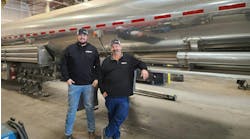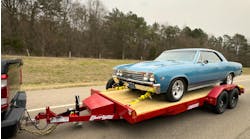PSI celebrates 1.5 million ATIS units sold as fleets recognize, address the many perils of low-pressure tires
According to Pressure Systems International’s Al Cohn, the National Football League spent $44 million while compiling a 248-page report on “DeflateGate,” in which quarterback Tom Brady and the New England Patriots were accused of deflating footballs to make them easier to throw and catch.
And after all the time and money spent investigating football air pressure, the verdict was inconclusive.
“In sum, the data did not produce a basis for us to determine with absolute certainty whether there was or was not tampering as the analysis of such data ultimately is dependent on assumptions and information that is not certain,” investigators said on page 228 of attorney Ted Wells’ report.
Cohn says, given the known variances in temperature and pressure gauge accuracy, among other factors, and their impact on measured psi (pounds per square inch), he could have said the same for a mere $3 million.
So when the veteran tire and tire pressure guru is willing to speak on these topics, and particularly the very real dangers of underinflation on the road, for free, it’s wise for fleet owners to listen.
“Even though we’ve been preaching this for about 40 years now, it’s still a big, big problem,” said Cohn, PSI’s director of new market development and engineering support, and the featured speaker for a combined PSI and Meritor event that included a tour of PSI’s San Antonio plant and the unveiling of a banner highlighting the 1.5 millionth Automatic Tire Inflation System (ATIS) sold.
Expanding company
PSI is a 26-year-old, privately held tire-solutions company. It formed a partnership with Meritor in the North American market in 1998, utilizing the commercial vehicle components supplier’s global reach in sales, marketing, service and distribution to grow the market for its “discretionary” product.
The results speak for themselves.
The company says 70% of the top 200 for-hire and private fleets in the United States have selected PSI’s ATIS as their preferred tire inflation system, which is a high adoption rate for an optional tool; and roughly 66% of the trailers built in North America that feature some type of tire solution deploy ATIS.
PSI’s growing product line also includes the TireView tire pressure monitoring system (TPMS), developed through its partnership with TPMS provider Truck System Technologies—which PSI acquired in 2017—and the ThermALERT wheel-end, heat-sensing system now standard on ATIS for trailers.
In addition, PSI recently announced new partnerships with Phillips Connect Technologies, which will provide telematics for PSI’s ATIS and TireView products; Truck-Lite, which integrated PSI’s technology into its Road Ready trailer monitoring system; and CIMC Intermodal Equipment, which now is offering ATIS as an option on its Revere chassis with a 10-year warranty.
The company touts its products’ proven return on investment, through savings in tire maintenance and replacement, and ability to meet any current or future environmental goals and regulations—and satisfy the California Air Resources Board’s GHG-2 rulemaking, which is set to take effect Jan 1, 2020—as the only tire solutions categorized as greenhouse gas (GHG) technologies.
“Tires are a challenge, and they’re also an opportunity,” said James Sharkey, PSI’s vice president of global sales and marketing. “In many cases, fleets have dealt with tires just because it’s been an ongoing problem, but they certainly view tires as a great way to save money and improve performance, not only on tires but in their full operations, from things like roadside inspections, and the impact there, to … getting the most out of all your tires, and certainly roadside haul-aways.
“At the end of the day, just like fuel, you can’t finish a run without air in your tires.”
A tiring problem
Tires remain the No. 1 maintenance issue for commercial fleets, and blowouts are the most common problem leading to road-side service calls, according to Cohn, a longtime employee of Goodyear Tire in various roles, including design and field engineering, before joining PSI in 2005.
The cost of a new set of truck and trailer tires is staggering.
In Cohn’s example, a set of 18 new Kelly steer, drive and trailer tires with the “latest and greatest” fuel-efficiency technology runs approximately $6,426, and with mounting, balancing, disposal and other services tacked on, that figure soars to $8,000—to replace the tires on one fleet asset.
Proper inflation can drastically reduce the amount of money fleets spend on tires through measurable, cost-saving improvements in tread wear and fuel economy, and fewer blowouts and tire changes. But ensuring all 18 tires have the correct pressure is another ongoing challenge for many reasons, including:
• The amount of time it takes to check 18 or more tires
• Checking them is a dirty job
• Inside dual tires are difficult to reach
• Inflation gauges are inaccurate
• Valve caps go missing after a pressure check
• Valve cores stick in cold temperatures and lose air
Trailer tires typically have the worst air pressure, Cohn said, and statistically, the standard pressure deviation increases from the front of the truck, where the steer tires usually boast the best air pressure, to the back of the trailer, where tire pressure is the least consistent—especially on that right rear inside dual.
“People just never get to that tire,” Cohn quipped.
Underinflation
And when it comes to maintaining proper tire pressure, over-inflation rarely is the critical issue, Cohn maintained.
“All that rubber you see on the road—we call it road alligators—normally is due to running tires underinflated,” he said. “It’s not due to overinflation—underinflation is the big issue—because … when you run underinflated, that’s where you generate all this heat in the tire, and heat is a tire’s worst enemy.
“Your footprint’s longer, so you’re generating more rubber on the road, you’re building up that heat, and eventually the tire’s going to fail.”
Common reasons for air loss include osmosis through the tire casing, which ranges from 1 to 5 psi monthly, tread punctures, sidewall damage from curb and other impacts, and leaky valve cores and stems. Cohn said when a tire fails due to air loss, it’s rarely a result of a bad re-tread or patch job.
The No. 1 cause of air loss is the tread puncture—and the most common culprit is the No. 20 penny nail.
“If this gets in the tread, in the groove, instead of losing 1 to 3 pounds a month, you can lose 1 to 3 pounds a day, or 3 to 5 pounds a day, and before you know it, you’ve got a big problem,” Cohn said.
“And that’s where the tire inflation systems are so valuable.”
When PSI’s ATIS detects air loss from a puncture or other cause, it automatically adds air to maintain pressure.
The system starts with a pressure protection valve, conveniently located to the left of the control box for easy maintenance, installed in the trailer air supply tank. Pressurized air flows into the control box, where it’s regulated to a pre-established, cold-air setting. Regulated air then flows from the control box through the hollow axle tube to the rotary union on the wheel end, where air is pneumatically transferred as needed, via the rotary union, into the tire hoses and into the tire.
And tires that aren’t underinflated are safer—and more efficient.
“(Underinflation) is why the rolling resistance is worse, why the fuel economy is worse, why the tire gets hotter and why it picks up more punctures—more rubber on the road,” Cohn said.









